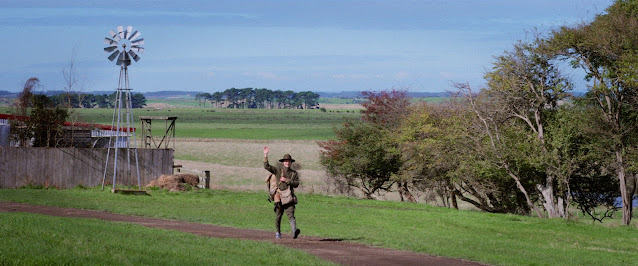November (2017)
November is a fairy tale that's at times sardonic, at others surreal and nightmarish, and never less than bewitching throughout. In the bleak fantasy world it depicts, those who live in squalor are forced to lie, cheat, and steal from one another to survive, while those who govern them simply hide away in their castles. Don't let its heavy themes and cynical worldview fool you, however: this film has a lot of heart and plenty of magic tricks up its sleeve. In the opening minutes of the film, we are immediately introduced to an obscure folkloric nugget: the Kratt, an automaton constructed of household garbage and given autonomy via black magic. The townspeople use these things to steal from each other, perform menial labor around the house, and just generally easing the burden of living in a filthy world ravaged by plague, inhabited by ghosts, werewolves, and even the devil himself. The lore is deep too. At one point, a snowman is brought to life in this fashion and while it proves to be unhelpful in getting things done in the physical sense, it has no end of fascinating stories to tell. Never before has the water cycle seemed so euphoric and spiritually rich. Indeed, the Kratt lore, despite being quite real and quite ancient, feels most analogous to sci-fi stories involving wayward artificial intelligences and humanoid androids. When someone wishes their Kratt to go away and leave them alone, for example, they need only to give them an impossible task like building a ladder out of bread, in a similar fashion to the classic sci-fi 'logic bomb' solution to malevolent AI, and then sit back and watch as they burst into flames.
In the end, though, this is all setting, and it would be nothing if it weren't for the two leads and their wonderful, if quirky, tale of romance in a world governed by the laws of old wives' tales and cautionary bedtime stories for children. Liina, a young village girl, is in love with Klaus, a young village boy, but their relationship is threatened when the local baroness arrives to rest in the country with her family and Klaus becomes totally smitten with her. Liina, however, will seemingly stop at nothing to reassert herself in Klaus's eyes, even if it means doing something unsavory. After all, she herself is a practicing werewolf, and her best friend is an old witch. How this all pans out is chilling and kind of awe-inspiring. Like ballet, the film comes off as perfectly deliberate, from its obscure opening to its strikingly surreal ending, and not a single frame feels wasted. There are great set-ups and even better payoffs, and the tone never wavers; it is always somewhere at the crossroad between dreamy and nightmarish, comical and horrifying, surreal and stark, fantastical and ugly.
In a perfect illustration of its contradictory nature, I introduce the visuals: black and white visuals to complement a fairy tale bursting with figurative color. They are some of the most captivating I've seen in some time. They're striking, they possess remarkable texture, and like another similar folk horror gem, A Field in England, their lack of color feels fitting for something so rooted in ancient history. On the audio front, things are more subdued, but the music and sound design is a perfect match for the look of the film; baroque instrumentation ebbs and flows gently, by turns playful and solemn, somehow perfectly matching both the lavish look of the film and its larger-than-life subject matter. In addition, what effects the film has appear to be entirely practical. The look of the Kratt in motion, especially, is impressive and it all feels one hundred percent real from start to finish, not to mention it's a helluva way to open your film and immediately grab your audience's attention.
November ended up being a great reminder of why I love world cinema so much; I learned old folk tales and campfire stories from an obscure part of the world I may have never encountered otherwise and gained a new appreciation for how one can take a very old story and tell it in a new and exciting way in order to achieve something akin to cinematic nirvana. If you have a beating human heart and like your films with a surreal tone and access to unfettered imagination, then you owe it to yourself to see what is easily one of the best folk horror films ever made.




Comments
Post a Comment